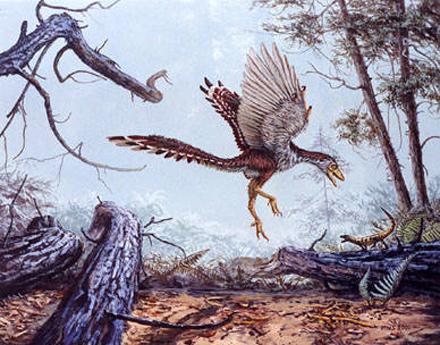
New fossil data shows that every time a dinosaur grew its limbs, a bird got its wings
We all know that birds are a living link to the age of the dinosaurs. It may be hard to imagine a pigeon that’s shaking you down for lunch crumbs as a Jurassic Park terror, but our feathered friends did in fact evolve from maniraptorans, a group of small, meat-eating theropod dinosaurs. But, until recently, we haven’t been clear on just what happened 150 million years ago to make those fellows take flight.
Using recently expanded fossil data, McGill professor Hans Larsson and former graduate student, Alexander Dececchi, set out to pinpoint the moment that maniraptorans got their wings.
Your pigeon pal has a wingspan that’s roughly double its body length. Carnivorous dinosaurs, however, had short forelimbs in relation to their body size. Until they didn’t. In a study published in the September issue of Evolution, Larsson and Dececchi showed that this long-stable limb-to-body ratio underwent a sudden shift. The forelimbs became dramatically larger, to the point where they were long enough to serve as an airfoil, allowing for flight. The hind limbs, meanwhile, shrank, which helped refine flight control and reduce in-flight drag. This combination of better wings with more compact legs would have been critical for the survival of birds in a time when another group of flying reptiles, the pterosaurs, dominated the skies.
“Our findings suggest that birds underwent an abrupt change in their developmental mechanisms, such that their forelimbs and hind limbs became subject to different length controls,” says Larsson, Canada Research Chair in Macroevolution at the Redpath Museum. Deviations from the rules of how an animal’s limbs scale with changes in body size – another example is the relatively long legs and short arms of humans – usually indicate some major shift in function or behaviour. “This decoupling may be fundamental to the success of birds, the most diverse class of land vertebrates on Earth today.”
“The origin of birds and powered flight is a classic major evolutionary transition,” says Dececchi, now a postdoctoral researcher at the University of South Dakota. “Our findings suggest that the limb lengths of birds had to be dissociated from general body size before they could radiate so successfully. It may be that this fact is what allowed them to become more than just another lineage of maniraptorans and led them to expand to the wide range of limb shapes and sizes present in today’s birds.”
“This work, coupled with our previous findings that the ancestors of birds were not tree dwellers, does much to illuminate the ecology of bird antecedents. Knowing where birds came from, and how they got to where they are now, is crucial for understanding how the modern world came to look the way it is.”
